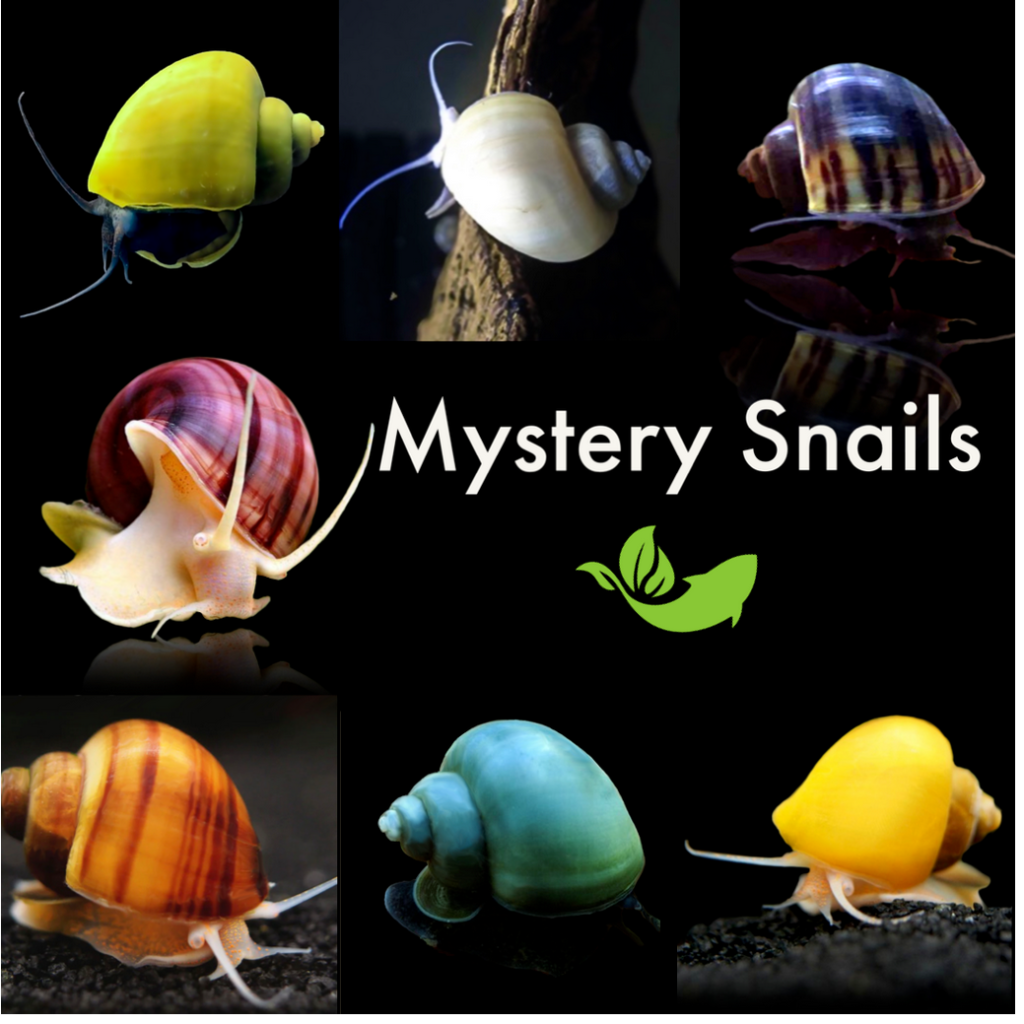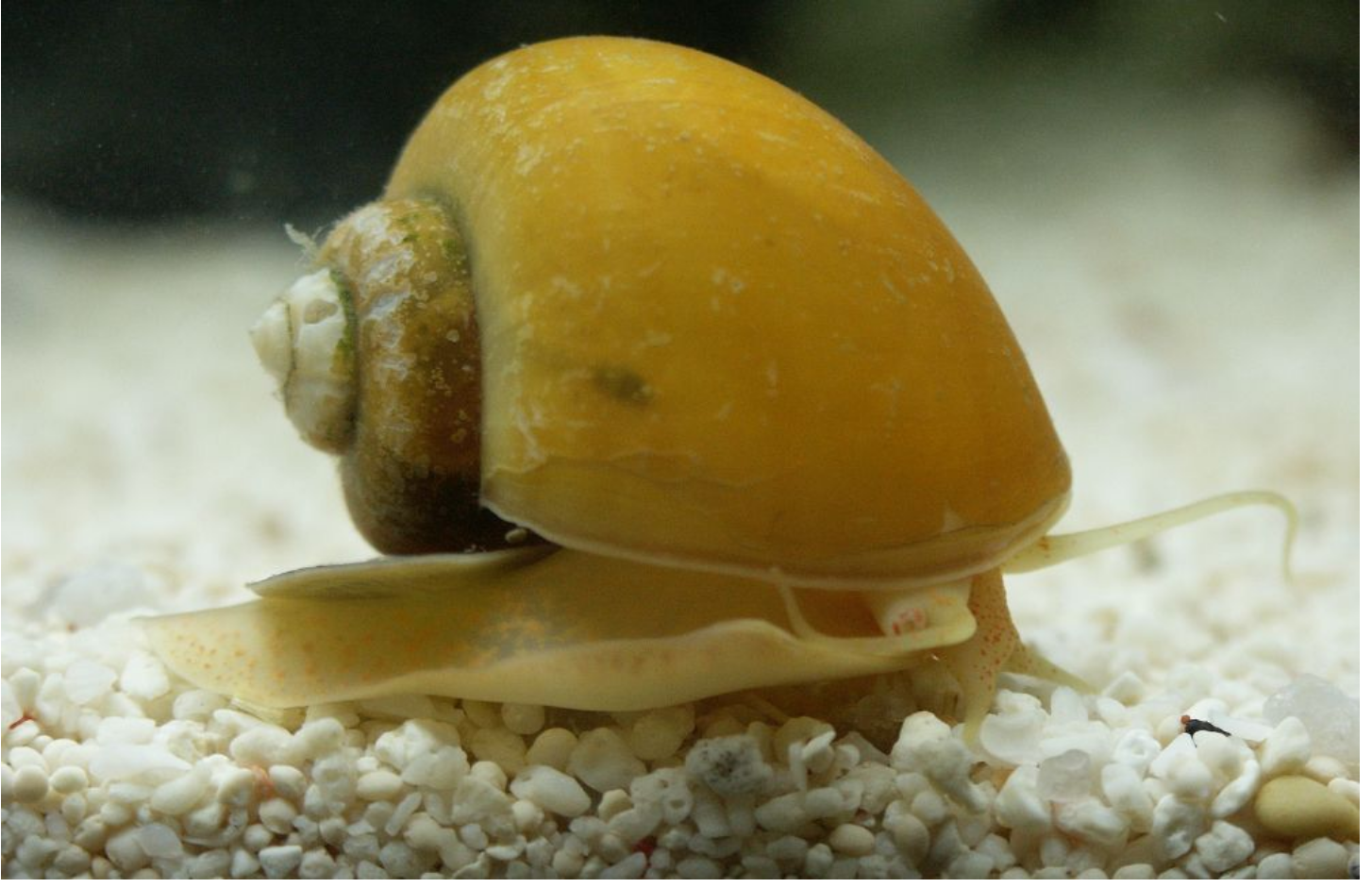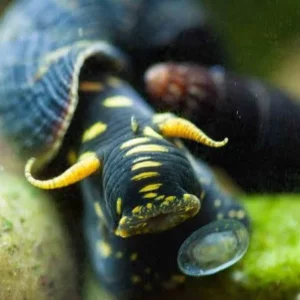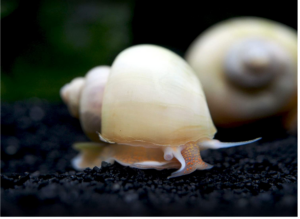Dive into the captivating world of mystery snails as we unravel the secrets behind these beloved aquatic creatures. Known for their exceptional ability to maintain aquarium algae levels, mystery snails have gained popularity among hobbyists.
Mystery snails’ diet includes algae, vegetation, and fish food remnants. Their tank mates include other snails and peaceful freshwater fish. In a tank size of a minimum of 4 gallons (15 liters) per snail, the temperature should be 20°C to 29°C (68°F to 84°F), and pH levels should be 7.6 to 8.4.
In this comprehensive guide, I delve into the origins of mystery snails, exploring their natural lifespan, habitat requirements, dietary needs, and intriguing breeding process. Prepare to enhance your care abilities and create a thriving environment for your mysterious companions.
Mystery Snail Origin and Natural Habitat

Different mystery snail species have been traced back to various origins by malacologists.
The most common species found in aquariums, the spike-topped apple snail (Pomacea bridgesii), is native to the freshwater bodies of South America, specifically Bolivia, Brazil, and Uruguay.
On the other hand, the Chinese mystery snail (Cipangopaludina chinensis) hails from Asia. It is widely believed that these snails were introduced to America in the early 1900s as a food source, with the earliest recorded sightings in California.
However, due to their invasive nature, Chinese mystery snails are less commonly encountered. While it is permissible to own, buy, transport, and sell them, introducing them into public water bodies is prohibited in most states.
This is because these snails can cause the following:
- Water systems to clog.
- Prey on other slow-moving creatures.
- Potentially transmit diseases.
Mystery snails are highly adaptable to the natural habitats of tropical freshwater environments, characterized by alternating periods of rainfall and drought. In such habitats, temperatures do not typically drop below 10 degrees Celsius (50°F).
Being moderately amphibious creatures, mystery snails can easily adjust to prevailing conditions suitable for freshwater fish.
Mystery Snail’s Natural Lifespan
A mystery snail typically has a lifespan of up to one year. However, with exceptional care, this can be extended to 1.5 years.
Expecting a mystery snail to live significantly longer, even with proper care, is overly ambitious. The blue and black varieties of captive mystery snails tend to have shorter lifespans than the golden or Inca snails.
Related Reading: How Long Do Snails Live?
The Appearance of Mystery Snails
Mystery snails exhibit a wide variety of color options, seemingly limitless. The head and body of a mystery snail typically feature shades of dark grey, whitish grey, or black, adorned with golden spots, markings, or speckles.
A common characteristic is a golden accent around the mouth, top of the mouth, and tentacles. However, the appearance of their shells can vary greatly. Shells may be solid in color or exhibit a gradient.
Popular color options for mystery snails include:
- Black
- Purple
- Blue
- Grey
- Orange
- Yellow
- Cream white
Among these, the black, blue, and golden mystery snails are the most frequently encountered in freshwater tanks.
Despite their primary color, mystery snails often display bright golden spots, stripes, or markings on their bodies, adding to their visual appeal.
Anatomically, mystery snails have a standard head shape with protruding eyes situated atop their heads. A notable feature of mystery snails is the siphon near their heads, which they use for respiration. This peculiar characteristic, absent in other freshwater snails, enables them to move water to their gills.
Additionally, mystery snails possess a modified gill known as an operculum. This secreted plate does the following:
- Acts as a protective door.
- Covers the aperture of the shell opening.
- Prevents desiccation.
The operculum proves particularly useful during dry seasons to prevent the snail from drying out. Mystery snails do not shed the operculum; its loss can indicate a serious illness.
When it comes to size, adult mystery snails typically measure around 2 inches (5 cm) in diameter. A diameter less than 1 inch (2.5 cm) indicates stunted growth, often resulting from inadequate care of the mystery snail.
Recommended Tank Size
Setting up a mystery snail tank can be challenging, with one of the trickiest aspects is determining the appropriate tank size. Opting for a larger tank is advantageous for providing optimal care to mystery snails.
Selecting suitable tank mates can also pose a challenge, given the potential presence of invasive species among mystery snails.
The recommended minimum tank size for a single mystery snail is 4 gallons (15 liters). If multiple mystery snails are to be kept together, the minimum tank size should be 8 gallons (30 liters).
It is important not to overcrowd your freshwater tank with too many mystery snails, as they have a substantial bioload, which can cause a spike in nitrate levels and disrupt water parameters.
Related Reading: Do Snails Increase Bioload?
I suggest incorporating adequate aquatic plants in the tank, striking a balance between sufficiency and excess.
While mystery snails consume algae adhered to the aquarium glass and fish waste on the substrate, they may also eat live plants. Therefore, a planted tank is preferable as it keeps the snails engaged in feeding on healthy plants, naturally occurring algae, and leftover fish food.
You may introduce a variety of plants, but consider species such as Java Moss and hornworts, as they are more tolerant of nibbling.
Mystery snails adapt well to various substrates, but it is advisable to avoid using overly coarse materials.
Since mystery snails are algae eaters, including a rock or two in the tank can provide excellent breeding spaces for algae.
I recommend the SunGrow Shrimp Rocks from Amazon for mystery snails. These rocks perfectly balance vitality, color, and growth, especially for baby snails. They are rich in calcium, essential for building stronger shells, and magnesium, which helps maintain vibrancy.
| Preview | Product | |
|---|---|---|

|
SunGrow Shrimp Rocks, for Crayfish, Hermit Crab, Snails, Crystal Red, Amano and Ghost Shrimps, 2… | Check Price |
Mystery Snails Water Parameters
Maintaining suitable water parameters is crucial for the well-being of mystery snails. Water quality directly impacts their overall health.
The key parameters to consider are:
- Temperature
- pH, hardness
- Lighting
The optimal water temperature for mystery snails ranges from 20°C to 29°C (68°F to 84°F). The preferred pH range for these aquatic snails is 7.6 to 8.4. It is crucial to maintain water hardness between 12 to 18 kH.
Additionally, ensure adequate lighting in your freshwater tank to monitor snail behavior effectively. Mystery snails require sufficient calcium for shell growth, so maintaining a high calcium density in the aquarium is also essential.
Feeding Mystery Snails
Paying careful attention to the diet of mystery snails is crucial for their overall health. Their primary dietary components include:
- Algae
- Vegetation
- Scavenging on fish food remnants
In aquariums with multiple snails, naturally occurring algae may not be sufficient, and algae wafers can be used as dietary supplements.
I recommend the Aquatic Arts Algae Wafers from Amazon for mystery snails. These sinking wafers contain premium ingredients such as algae, spirulina, veggies, fish, kelp, shrimp, and krill, providing optimum nutrition for your snails. With over 30% protein, they promote faster growth, breeding, and vibrant colors in your invertebrates.
| Preview | Product | |
|---|---|---|

|
Aquatic Arts Algae Wafers (8 Ounce) Sinking Food for Live Aquarium Shrimp, Fish (Pleco/Tetra),… | Check Price |
Fresh vegetables such as kale, cucumber, and spinach are also excellent food options. In shared tanks, blanched vegetables are a better choice to cater to the needs of other tank inhabitants.
Avoid overfeeding, as excessive food can lead to nitrogen release during decomposition, significantly compromising water quality.
Keeping your tank clean promotes healthy plants and happier mystery snails.
Related Reading: Can You Use ParaGuard With Snails?
Breeding Mystery Snails
Breeding mystery snails is an easy and fascinating process. Simply place male snails in tanks with predominantly female snails and let nature take its course.
Determining the gender of mystery snails can be challenging, but observing mating behavior is the easiest way to identify them.
Altering water parameters to stimulate breeding is not necessary; just be patient and let the snails do their thing.
After mating, female mystery snails will lay eggs in a distinctive lumpy pattern on the water’s surface. These eggs will remain at the waterline and hatch into tiny baby snails after a few weeks.
While these baby snails don’t require special care, it’s important to monitor water parameters closely due to their contribution to the bioload. They may be more sensitive to poor water quality than adult mystery snails.
Consider moving the baby snails to a separate tank after a few weeks to regulate the bioload.
Related Reading: How Do Snails Reproduce?
Mystery Snails Tank Mates
Mystery snails coexist well with other freshwater snails and peaceful freshwater fish. Essentially, any creature that doesn’t rely on the same diet as mystery snails in the wild can be a suitable tank mate.
Due to their slow and non-intrusive nature, most tank mates barely take notice of mystery snails. However, invasive species of mystery snails should not be housed with non-invasive snail species.
Common tank mates for mystery snails include tropical fish such as:
- Tetras
- Killifish
- Cory catfish
- Otocinclus
Interestingly, you can also keep Betta fish together with mystery snails. They tend to stay out of each other’s way.
Betta fish are popular aquarium pets, and keeping them with mystery snails has several benefits:
- The mystery snail helps clean the tank.
- The Betta fish ensures the mystery snail receives sufficient food.
Understanding Mystery Tank Behavior
Mystery snails are peaceful creatures that prefer to be left undisturbed. They are generally unconcerned about what is happening in other parts of the tank.
When faced with a threat, a mystery snail will retreat into its shell until the danger passes. However, with suitable tank mates, there is usually little cause for concern or realistic threats for mystery snails.
As avid algae eaters, they focus on scavenging the tank for algae and leftover food like fish flakes.
Occasionally, you may spot a mystery snail floating in the community tank, which is not a cause for alarm unless it persists for an extended period. Prolonged floating could indicate illness and the snail being near death.
Providing Proper Care for Mystery Snails
Proper care is crucial for maintaining the health of mystery snails, as they are sensitive to poor water quality. Even slight changes in water parameters can shock and harm these delicate creatures. Prolonged exposure to suboptimal water conditions can adversely affect their overall well-being.
While mystery snails don’t have specific known diseases, they are susceptible to fish diseases, which can be fatal.
Monitoring the copper concentration in your mystery snail tank is essential, as invertebrates are allergic to copper. High levels of copper can negatively impact both their body and shell health.
Observing the behavior and appearance of your mystery snails regularly is the easiest way to identify potential health issues.
The following unusual signs indicate that something is amiss:
- Cracked shells.
- Color changes.
- Lack of movement or decreased activity levels.
Cracked, thin, or excessively pitted shells often indicate calcium deficiency in the water.
How Mystery Snails Compare With Other Freshwater Snails
Mystical snails are generally smaller than other freshwater snails, with a maximum diameter of 2 inches (5 cm). In contrast, some species, like the Giant Sulawesi, can grow up to 4 inches (10 cm) in diameter. The smaller size of mystery snails results in a lower bioload.
Malacologists have also observed that mystery snails tend to have healthier shells, contributing to their longer lifespan.
Mystery snails also have fewer known issues compared to other snail species. They are less susceptible to shell rot, a significant threat to snail health.
As long as predators don’t attack their shells and water parameters are carefully monitored, mystery snails typically encounter fewer problems.
Wrapping It Up
The mystery snail is a popular choice for aquarium enthusiasts as they can quickly adapt to most standard tropical tanks. I highly recommend this species, especially for beginners, as they are easy to care for and less prone to common snail-related issues.
Their smaller size and healthier shells contribute to their longer lifespan. It’s fascinating to observe their deceptive behaviors and mating activities.
Starting your aquarium hobby with mystery snails is a great choice. I hope this guide has helped clarify various aspects of keeping them.
Sources
- Quora: Why is my mystery snail floating to the top of the tank instead of attaching to the wall?
- Pets on Mom.com: The Average Lifespan of a Mystery Snail
- Minnesota Department of Natural Resources: Chinese Mystery Snail (Cipangopaludina chinensis)
- NIH: Locking of the operculum in a water snail: Theoretical modeling and applications for mechanical sealing
- PetHelpful: Planted Aquarium Basics: How to Set Up a Planted Tank



